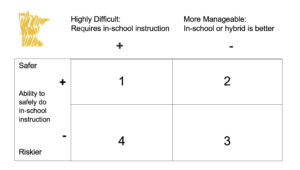The new hybrid learning model outlined by the Minnesota Department of Education and state health officials requires schools to develop new master schedules to accommodate reduced capacity and strict social distancing for in-person instruction.
The guidance from state education and health officials released June 18 places parameters on both in-school and off-site (distance) learning.
- In-school parameters include the number of students who can be 6’ apart in instructional spaces with a maximum of 50% of occupancy, and transportation limits.
- Off-site (distancing learning) parameters include MDE membership and attendance guidance, and districts’ and families’ technology limitations.
All of these need to work together. This necessitates that a school district:
- First, develop a district master schedule of the In-School Cycle to meets all these parameters.
- Then, work out a transportation plan.
- Last, develop master schedules by building for In-School and Off-Site learning and assign teachers, paraprofessionals and students.
MREA developed this guide with associate partners to assist school districts in these decisions.
Key Steps
June 23-July 24
1. Appoint COVID-19 Program Coordinator(s)
Identify a point of contact for each school building in collaboration with school nurses.
For MDH requirements and recommendations, see pages 4 of MDH Guidance for Schools.
2. Prioritize courses and students for in-school instruction
This allows schools to bring students to school for safe in-person instruction and not rely mainly on distance learning. The following 2X2 chart is a starting point to conceptualize the approach that would best meet the district’s needs.
Courses and Students Degree of Difficulty in Distance Learning

The course safety rankings are from NG Carlson Analytical Inc. and provided by MREA associate member ICS.
Possible courses by quadrant:
- Highly difficult to do distance learning, Requires in-school Instruction, and can be done safely in-school for students and staff more easily.
- Secondary CTE with specialized equipment
- Primary reading and math
- World languages
- More manageable in distance learning, In-school or hybrid is better, and can be done safely in-school for students and staff more easily.
- Most academic courses grades 4 and up, when most students can read to learn
- Students in LD or Title I and need additional instruction
- This will be the majority of students and courses
- More manageable in distance learning, In-school or hybrid is better, is riskier to do safely in-school for students and staff.
- Choir, band, PE indoors due forced exhalation
- Speech therapy for articulation without protective PPE
- Highly difficult to do distance learning, Requires in-school Instruction, but is riskier to do safely in-school for students and staff.
- SPED students who need physical closeness for instruction and safety
- PE indoors
For MDH requirements and recommendations, see pages 5-6 of MDH Guidance for Schools.
3. Determine length of Master Schedule Cycle
Schools will consider A, AB, ABC, ABCD. MREA created an interactive Master Schedule Cycle spreadsheet to help schools calculate and assess varying approaches, based on state guidance.
Download Hybrid Master Schedule Cycle Tool:
Listen to narration on using the tool:
Tool Considerations
- The worksheet is designed to be the reference point for conversations about the types of students and how often will they receive In-School instruction. The more widely the net is cast to engage stakeholders in these conversations before making a final decision, the better the decision will be understood and accepted.
- The easiest way to start is to click on the Example tab and play with the variables to see how the worksheet works.
- This worksheet will create four options for cycles of multiple day schedules by rounding up and down to whole numbers of days. Two options are with current classrooms and two with additional classrooms from subdividing larger spaces such as gyms.
- There are 11 variables to enter which were gathered in the pre-planning phase. See Notes Tab on MREA Master Schedules Cycle Worksheet for more information.
Calculating
- To calculate the number of students who can be In-School in the Hybrid scenario, both MDH and MDE guidance in the Hybrid model require 6’ of social distancing at all times with “50% maximum occupancy.”
- ‘Maximum occupancy’ refers to the Fire Marshall occupancy number for all interior spaces. This is in districts’ architectural documentation. Contact a facility advisor for assistance. View a list of MREA facility Associate Members.
- Deciding whether to round up or down is an important judgement. Rounding up creates more opportunity for those who need more in-school instruction but lowers the total number of days in the course of the year for other students.
- Rounding down does the opposite. These choices will be an important part of conversations with stakeholders.
Now you are ready to enter your District Level ten variables 10 variables in column C.
District Entered Variables Defined |
Enter Data |
| Number of licensed teachers | 0 |
| Percent of teachers who will be assigned to base cycle classrooms–See Exclusions in Notes to Worksheet | 0% |
| Number of K-12 students | 0 |
| Percent whose parents would be willing to send them to school this fall | 0% |
| Number of K-12 students who would benefit educationally more by being in school more than the base schedule (ie. primary students, LD, ELL, CTE) | 0 |
| Current number of classrooms approximately 900 square ft or more | 0 |
| Additional classrooms gained through subdividing larger spaces or community partners | 0 |
| Maximum number of students per teacher or supervising adult per classroom allowed by MDE guidance (current summer school guidance) | 0 |
| Number of instructional days in district calendar (Not holiday, inservice, etc) | 0 |
| Number of Para professionals | 0 |
| Percent who are able (do not have underlying health condition) and would be willing to work In-School and will be assigned to classrooms and not other duties | 0% |
Using the Tool
- Save the District Level Cycle to a new worksheet in the workbook.
- Re-enter the variables for each building, saving each worksheet.
- Match the buildings with the district worksheet to see if each building has the spaces to conduct its program within the cycle. Grades may have to move to new buildings to be sure each building can operate within the cycle.
- Make a tentative determination of the length of the cycle and move to transportation.
4. Determine transportation capacities.
This may be the upper limit of students who can be transported to school on any given day. For MDH requirements and recommendations, see page 14 of MDH Guidance for Schools Thanks to Palmer Bus for assistance in this guidance.
Key steps include:
- Calculate number of students that can be transported in one set of runs.
- Expand walking zone to the current guidelines.
- Consider ways to increase transportation capacity.
- Add up all transportation capacity in 1, 2, 3. This is the number of student who can be transported in a day. Compare with these two cells in the Master schedule worksheet derived from the classroom capacity.
| The smaller number of (1) students who can be In-School on any given day with current classrooms or (2) max number of students transported in all modes | 0 |
| The smaller number of (1) students who can be In-School on any given day with additional classrooms or (2) max number of students transported in all modes | 0 |
Your planning teams will need to continue extensive conversations with union reps and individual staff to get everyone on board with equitable workloads that will effectively educate students, especially in the next step to determine the length of day and school calendar.
5. Determine length of In-School day and school calendar.
This needs to safely meet MDE membership and attendance guidance.
- Safety will depend on ventilation in addition to social distancing. (See ventilation information in Pre-planning and Implementation Phases.) For MDH requirements and recommendations, see page 13 of MDH Guidance for Schools.
- Calculate hours of instruction to meet MDE guidance on meeting minimum hour requirements found on pages 50-53 of MDE Planning Guidance for Minnesota Public Schools
- Need to provide time for office hours for students doing the extensions of in-school instruction when they are at home or
- Consider putting teams of teachers together for the same grade level or secondary academic discipline. Some of whom will instruct all off-site lessons and daily contact with students. This includes those students on 100% Distance Learning and hybrid students when they are Off-Site. In-School teachers focus on In-School instruction.
- This enables students to move back and forth between the models, but will take coordination, communication and similar pacing.
- These assignments may change the number of teachers available for In-School instruction. This means you will need to re-run the Master Schedule Cycle worksheet again to confirm or change your initial decision on length of cycle.
- Provide statutory prep time for teachers since when students are in school teachers are with students the entire time
- Provide collaborative planning time and in-service training and support
- Consider having lunch delivered to classrooms. see page 5 of MDH Guidance for Schools
- If you can get all this done by mid-July, MDE has re-opened the flexible year applications if your district wants to start before Labor Day. Application deadline is July 31, and you must have held three public hearings by then. See Flexible Learning Year Application 2020-21
Implications for Secondary Schools
- Think in time blocks. Four time blocks would enable 9-11th graders and middle schooler to take their core required credit classes for graduation such as English, Math, Social Studies, and Science on their ‘on cycle day.’
- Guidelines recommend limiting the movement of students. Consider moving teachers and not students for heterogeneously grouped classes for these required credit classes. Science labs would be an exception.
- Schools may want students may take electives on their off-cycle days. Elective teachers teach every day, because every day is off-cycle for one or more groups of students. Schools may consider ‘blocking’ these electives to minimize the number of courses students take. This will also make it more likely that students can take two elective in an off-cycle day.
- Schools may want some electives to be Off Site for safety reasons such as band and choir and only schedule PE during months conducive to outdoor activity.
Implications for Elementary Schools
- Primary grades will need more classrooms to have students attend additional days.
- Staffing those classrooms may include classroom music and PE teachers, or teaming up paraprofessionals to supervise and teach two classrooms.
- Districts may want to consider moving upper elementary classrooms to other buildings to get more classroom space for primary grades.
Implications for Special Education
- Supports for LD, speech, ELL occur on the off-cycle schedule days.
- Intensive Level 4, DCD, and services in which social distance is not possible are governed by MDE guidance and added to the transportation system according to guidance.
July 27-August 7
Have your board make a decision to move forward on a recommended Hybrid model and master schedule cycle.
This should come as soon as possible after MDE announces “which model of educational delivery will be in the best interest of the health and safety of our students, school staff and school communities for the 2020-21 school year by the week of July 27, 2020.” (MDE COVID-19)
If the conversations in the district have been robust and inclusive, people should be ready for this decision and begin to actually build the schedules, know what is expected, and get to detailed planning and preparation for re-opening in the fall.
6. Get final approval to re-open in this hybrid model.
- Communicate the outlines widely for the hybrid model. The alternative being distance learning only.
- Hold a board virtual meeting.
- Have board make a decision to move forward. To actually schedule students and begin the implementation process and training are even more complex than the work so far.
- If the decision is to proceed with a hybrid model, go to final steps.
- If the decision is to open in Distance Learning model only, go MREA Distance Learning Planning.
August 3 until completed
Final Steps in building your master schedules: Integrating transportation and building level master schedules.
- Inform parents of the outline of the cycle and building plans for In-School instruction
- Give families the choice to go distance learning only due to underlying health conditions or reluctance to send children to school.
- Decide when the next option to choose In-School instruction will be.
Considerations
- There will be a dance between transportation and buildings master schedules.
- The capacity of your SIS scheduling component comes into play here. Principals and counselors may be doing a lot of hand-scheduling.
- Buildings will need to communicate closely with each other and transportation.
Getting Started
- Start with your base cycle days and transportation system. Based on neighborhoods and location who will be brought to school on which cycle day. Bring whole families in on the same cycle day. They can sit together.
- If you double route, match a longer route with a shorter one so the overall time for all doubled routes is about the same.
- Districts with multiple buildings may consider using some buses to shuttle students during the second, shorter route time, rather than having route buses go to all sites.
- For the students coming in for additional “off cycle days,” first use your transportation system for those who have no other option and fill up the busses to the CDC limits.
- Transportation provides each building the roster of students per day in cycle.
- Buildings use walkers, students driving families, and carpoolers to complete the base cycle and off-cycle days.
- Those student rosters become the students in the master schedule for each day.
- Do a final check for equity that students who need to be in multiple days are scheduled for multiple days with some transportation option.
- Do a final check to see that you are at least at the max per day as calculated in the Master Schedule Cycle worksheet.
What’s Next?
While principals and counselors are building their building master schedules in concert with transportation and in communications with affected staff, districts need to begin the next phase: Implement and Operationalize
…………………………………..
Taking Action
MREA developed extensive guides and resources to implement a new hybrid learning model with these key planning phases:
- Assess
- Pre-Plan
- Build New Master Schedules (with interactive worksheet)
- Implement and Operationalize
- Communicate
Stay Connected
Stay connected to news and resources on reopening schools in Minnesota: mreavoice.org/reopeningschools





